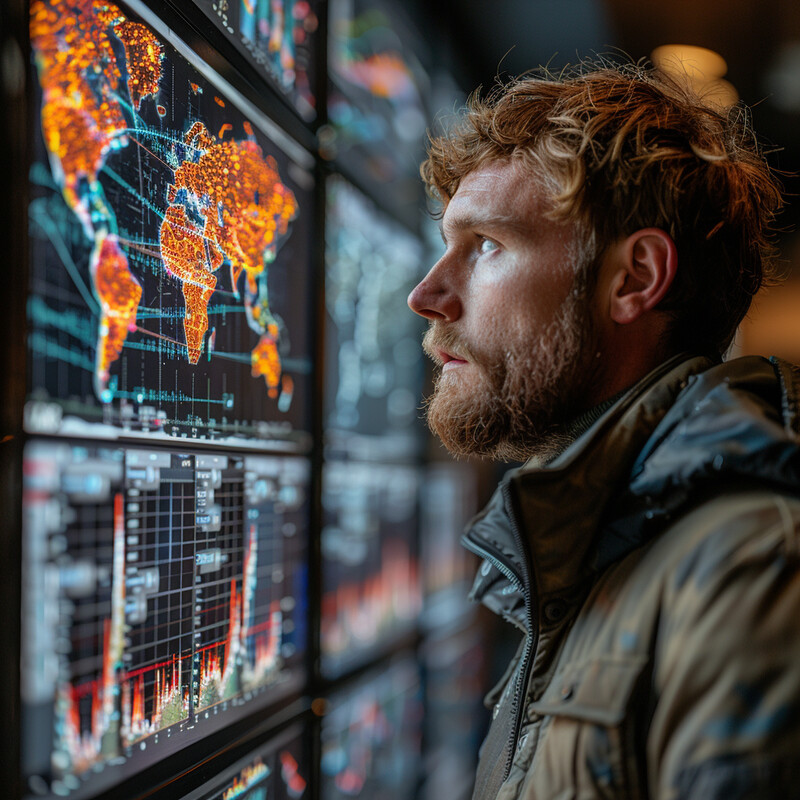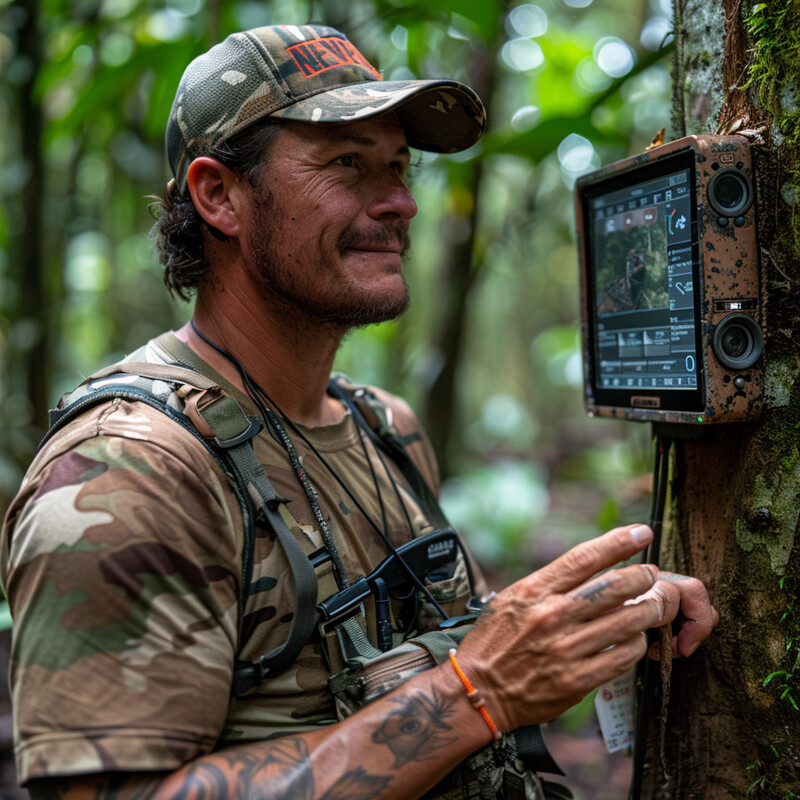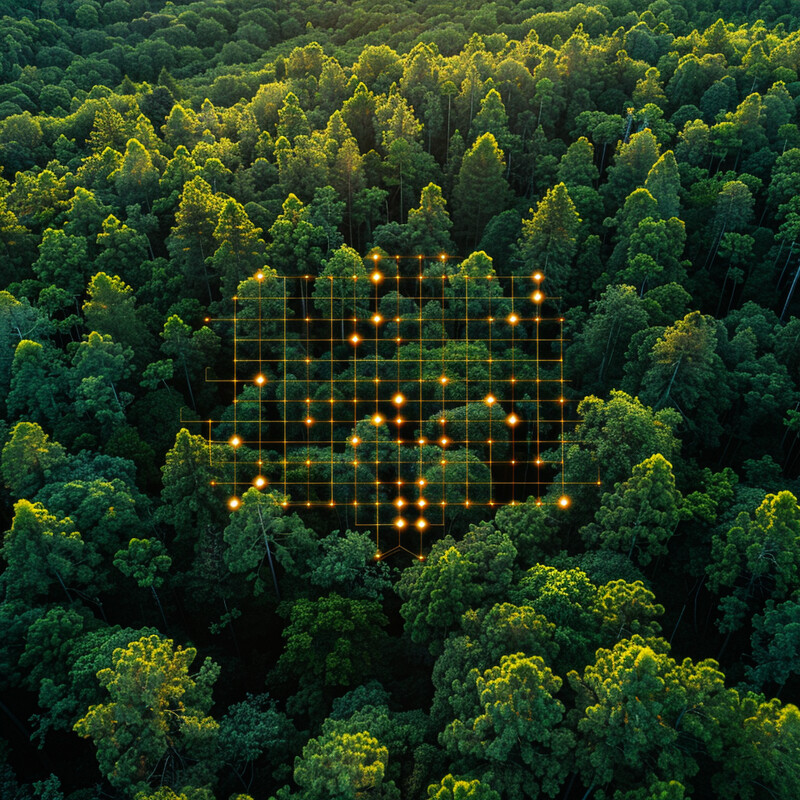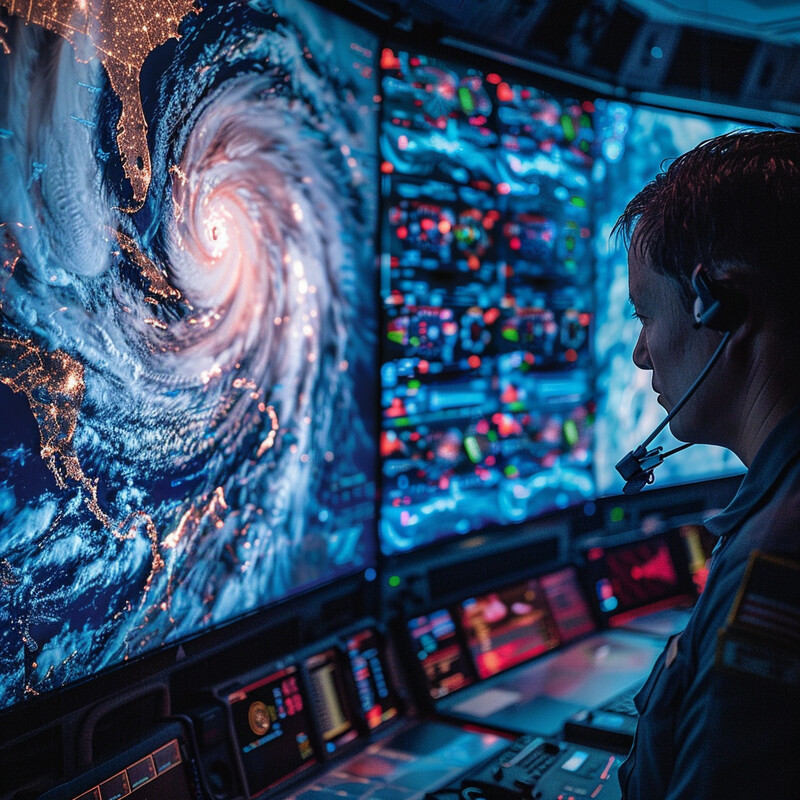1. Climate Change Modeling
AI is transforming climate change modeling by processing immense data sets to improve predictions of future climate conditions. Machine learning algorithms can identify subtle patterns in historical climate data, leading to more accurate projections of temperature rises, sea-level changes, and extreme weather events. These AI-enhanced models help scientists and policymakers understand potential climate futures and evaluate the impacts of different emissions scenarios. By refining uncertainty ranges, AI-driven climate models support better-informed adaptation and mitigation strategies. Overall, AI contributes to earlier warnings and more robust climate policy planning by enhancing the precision and scale of climate simulations.

A 2024 study demonstrated AI’s power to refine climate projections. Researchers trained an AI system on decades of climate simulations and real observations, and found a greater than 99% chance that global warming will exceed 1.5°C above pre-industrial levels even with rapid emissions cuts. Notably, the AI-driven model projected about a 50% probability that warming will surpass 2°C by mid-century even if global carbon neutrality is achieved in the 2050s. These findings, published in Geophysical Research Letters, suggest that previous models may have been too optimistic and highlight how AI can uncover higher risks of extreme warming. The result underscores the urgency for climate resilience measures, as AI forecasts indicate more severe future conditions than earlier estimates.
2. Air Quality Monitoring
AI plays a pivotal role in real-time air quality monitoring by analyzing data from networks of sensors and satellites. Intelligent algorithms can detect pollutants like particulate matter (PM₂.₅), nitrogen dioxide, and ozone across cities and regions continuously. This enables early identification of pollution hotspots and trends that human monitoring might miss. With AI’s pattern recognition, environmental agencies can pinpoint emission sources and issue health warnings faster. The improved surveillance and analysis help policymakers enforce air quality regulations more effectively and devise targeted pollution mitigation strategies. In essence, AI-driven monitoring provides a more detailed and timely picture of air quality, which is crucial for protecting public health and reducing exposure to harmful air pollution.

Recent research shows that incorporating AI significantly improves air pollution exposure assessments. In 2023, a Penn State-led team used machine learning with data from low-cost sensors and found the approach improved the accuracy of PM₂.₅ exposure models by an average of 17.5%. By integrating AI and mobility data, their model captured more fine-grained spatial variations in pollution than traditional methods. This 17.5% boost in predictive accuracy means officials can better identify neighborhoods with unhealthy air and high pedestrian traffic, allowing more timely alerts and interventions. The peer-reviewed study in Frontiers in Environmental Science demonstrates how AI enhancements to air quality models can lead to more precise monitoring and ultimately help reduce health risks from air pollution.
3. Water Quality Assessment
AI enhances water quality monitoring by rapidly analyzing sensor and satellite data for signs of contamination. Machine learning models can detect pollutants in rivers, lakes, and reservoirs—such as heavy metals, nitrates, or harmful microbes—more quickly than traditional lab tests. This allows water agencies to identify pollution events or trends (like industrial discharges or algal blooms) in near real time. With AI’s ability to handle complex, sparse data, it can predict water quality issues even with limited samples, guiding where to test or treat water supplies. Such predictive monitoring is vital for safeguarding aquatic ecosystems and public health, as it enables earlier interventions to prevent waterborne disease outbreaks or ecological damage. In short, AI provides a smarter, more proactive approach to ensuring clean and safe water.

A 2024 study used AI to fill critical gaps in groundwater quality data and revealed far more risk than previously documented. The machine-learning framework, developed by researchers at NC State and partners, analyzed limited well samples and predicted that many more groundwater sources exceed safe drinking-water standards than field tests showed. While on-site measurements indicated 75–80% of sampled wells met safety limits, the AI model estimated that only 15–55% of these sources might truly be risk-free. In other words, the AI flagged numerous unseen contamination issues, prompting authorities to prioritize additional testing at those sites. Published in Environmental Science & Technology, this work demonstrates how AI can uncover hidden water pollution threats and guide more efficient monitoring and remediation efforts.
4. Wildlife Conservation
AI is revolutionizing wildlife conservation by automating the detection and tracking of animals in their natural habitats. Conservationists use AI-equipped camera traps and drones that can identify species from photos, recognize individual animals, and even flag poachers in real time. This dramatically increases the scale and speed of data collection on wildlife populations and their behaviors. By removing manual bottlenecks, AI enables continuous monitoring of endangered species with minimal human disturbance. It helps estimate population sizes, map migration routes, and detect changes in animal distribution due to threats or climate shifts. Ultimately, AI-driven tools provide conservationists with richer and more timely information, informing better strategies to protect biodiversity and combat illegal wildlife trade.

AI systems can process wildlife data orders of magnitude faster than humans, yielding enormous conservation benefits. For example, World Wildlife Fund’s Wildlife Insights platform uses AI to automatically filter and classify images from camera traps. In a 2023 post-wildfire recovery project in Australia, this system sorted through 7 million camera-trap photos in just a few weeks, identifying over 150 different animal species in the process. By comparison, a human would take an estimated four years to manually review that many images. Wildlife Insights currently recognizes more than 1,300 species of animals from images, even from partial glimpses like an animal’s tail. This AI-driven efficiency is providing conservation teams with near-real-time data on species presence and abundance, vastly improving wildlife monitoring after events like bushfires.
5. Deforestation Detection
AI is being deployed to detect deforestation early by analyzing satellite imagery for changes in forest cover. Automated image classifiers can scan huge swaths of land and pinpoint areas where tree loss is occurring, often in near real time. This helps authorities catch illegal logging or land clearing much faster than waiting for on-the-ground reports. AI-based deforestation alerts enable quicker responses—such as sending park rangers or law enforcement—potentially preventing further forest loss. They also improve the accuracy of forest monitoring by reducing false alarms (e.g., distinguishing logging from seasonal changes). Moreover, AI can estimate the extent of deforestation and project its carbon emission impacts. By providing timely, granular data on forest changes, AI supports better conservation enforcement and policy-making to curb deforestation and associated climate effects.

The urgency for AI-driven deforestation monitoring is underscored by recent trends in forest loss. In the Brazilian Amazon, deforestation surged by 140% from 2012 to 2020, culminating in a loss of about 13,200 km² of rainforest between August 2020 and July 2021. To combat such rapid clearing, researchers have developed AI models to automatically validate deforestation alerts using high-resolution satellite images. These deep learning systems can confirm new deforestation events with high accuracy, greatly speeding up what used to be a slow, manual verification process. By 2024, tests in the Amazon showed that AI could reliably identify recent forest loss even from 3–4 m resolution imagery, enabling near-real-time monitoring of illegal logging. This technological leap means governments and conservationists can respond faster to protect forests in critical regions.
6. Natural Disaster Prediction and Response
AI is enhancing the prediction of natural disasters and improving emergency responses. Advanced machine learning models ingest vast meteorological and geological data to forecast events like hurricanes, floods, and earthquakes with greater lead time and accuracy. For instance, AI can quickly simulate thousands of weather scenarios to better predict a hurricane’s path and intensity. These improved forecasts allow disaster management teams to evacuate or shelter communities more efficiently, potentially saving lives. AI also aids responders by analyzing real-time data (social media, sensors, satellite images) during disasters to map damage or prioritize resources. Furthermore, AI-powered drones and robots can assist in search-and-rescue operations in hazardous conditions. By making disaster prediction faster and more precise, AI helps authorities move from reactive to proactive—strengthening preparedness and minimizing the impacts of natural catastrophes.

Artificial intelligence has recently achieved breakthrough results in weather and hurricane forecasting. In late 2024, Google DeepMind unveiled an AI system called GenCast that outperformed the leading global weather model by up to 20% in accuracy for short-term forecasts. GenCast was tested against the European Centre’s ensemble (ENS) model and delivered more accurate predictions for day-to-day weather conditions and extreme events up to 15 days in advance. Crucially, this AI model showed superior skill in predicting the tracks of destructive hurricanes and other tropical cyclones, including landfall locations. These results, reported in Nature and the media, mark an inflection point where AI-based forecasts are now rivaling or beating traditional physics-based models. The improved early warning from such AI advances allows for more effective evacuations and disaster response planning.
7. Agricultural Monitoring
AI-driven technologies are enabling more sustainable and productive agriculture by closely monitoring crops and soil conditions. Machine learning models can analyze weather patterns, soil data, and plant health indicators to help farmers optimize planting and irrigation schedules. Drones and satellites equipped with AI image analysis detect early signs of plant stress, diseases, or pest outbreaks in fields, allowing targeted interventions before problems spread. These precision agriculture techniques reduce the need for excessive fertilizer and pesticides by ensuring inputs are used only where needed. AI can also predict crop yields more accurately, assisting farm management and supply chain planning. Overall, constant monitoring and predictive analytics make farming more efficient, boosting yields while minimizing environmental impact through smarter use of resources.

AI innovations in agriculture are achieving striking reductions in chemical use. Bloomberg News reported in 2024 that new AI-guided “smart sprayers” can cut herbicide usage by as much as 90% by targeting weeds more precisely. For example, John Deere has introduced a tractor-mounted sprayer that uses computer vision and machine learning to distinguish crops from weeds, allowing it to reduce herbicide application by up to 77% compared to conventional spraying. Similarly, an autonomous robotic sprayer developed by a tech startup was shown to lower herbicide volumes by over 90% in field trials. These advances mean far less chemical runoff into soil and water, reduced costs for farmers, and lower greenhouse gas emissions from producing and applying farm chemicals. AI-powered precision farming tools thus make agriculture more environmentally friendly while maintaining crop productivity.
8. Energy Consumption Analysis
AI is being used to analyze and reduce energy consumption in buildings and industry for a smaller carbon footprint. Smart energy management systems employ AI to learn usage patterns and control heating, cooling, and lighting more efficiently in real time. For instance, AI can predict when different parts of a building will be occupied and adjust HVAC settings accordingly, avoiding wasteful overheating or overcooling. In manufacturing, AI algorithms optimize processes to use only the necessary energy at each step. Even in power grids, AI helps balance supply and demand, integrating renewable sources more smoothly. By identifying inefficiencies that humans might overlook, AI-driven analytics often reveal opportunities to save electricity or fuel. Many businesses have reported significant energy savings and cost reductions after deploying AI for energy monitoring and optimization, contributing to both economic and environmental goals.

Scientists have begun quantifying how much AI could cut energy use on a large scale. In 2024, a study in Nature Communications examined AI-controlled HVAC systems in commercial buildings and found that adopting AI could lower building energy consumption by roughly 8% to 19% by 2050. This analysis by researchers at Lawrence Berkeley National Lab modeled medium-sized office buildings across different climate zones. They concluded that machine-learning optimizers for heating, ventilation, and air conditioning can yield substantial efficiency gains (on the order of a tenth less energy use) under typical conditions. Moreover, when AI is combined with aggressive energy policies and cleaner electricity, the study projected up to a 40% reduction in building energy use and 90% cut in emissions versus business-as-usual scenarios by mid-century. These findings highlight AI’s promising role in meeting climate targets through smarter energy management.
9. Waste Management Optimization
AI is helping revolutionize waste management by making recycling and collection systems more efficient. In recycling facilities, AI-powered robots and computer vision systems can sort through mixed waste streams at high speed, identifying and separating recyclables (plastics, paper, metals) with greater accuracy than human workers. This increases recycling rates and reduces contamination (when wrong items end up in recycling). On the collection side, cities are using AI to plan optimal garbage truck routes based on real-time data like bin fill levels or traffic, which cuts fuel usage and emissions. AI analytics can also predict waste generation patterns, helping sanitation departments allocate resources better and schedule pickups only when needed. By improving both the sorting and transport of waste, AI contributes to lower operational costs, higher recycling yields, and ultimately less waste ending up in landfills or the environment.

AI-driven sorting technology is already boosting recycling outcomes. In 2024, the Can Manufacturers Institute reported that installing AI robotic sorters in just six recycling facilities across the U.S. will enable the recovery of an extra 115 million aluminum cans per year, generating an estimated $1.8 million in additional revenue for those facilities. One such plant in Chicago added an AI-enabled robot on its “last chance” sorting line; the robot paid for itself in under a year by plucking out thousands of stray aluminum cans that would have been missed by humans. These systems, developed by companies like EverestLabs and AMP Robotics, can identify recyclables with over 95% accuracy, significantly improving material purity. The result is a higher recycling rate and less valuable material being wasted, illustrating the economic and environmental payoffs from AI in waste management.
10. Ocean Health Monitoring
AI is increasingly vital for monitoring ocean health, allowing scientists to track marine conditions over vast areas and timeframes. Machine learning models analyze streams of data from ocean sensors, buoys, and satellites—covering metrics like water temperature, acidity (pH), salinity, and pollutant levels—to detect changes that could indicate ecological problems. For example, AI algorithms can identify early signs of coral reef bleaching by recognizing subtle shifts in color and temperature patterns in satellite imagery. They can also help locate illegal fishing or map undersea habitats by classifying vessel movements and seafloor images. This level of automated analysis provides a continuous “eye” on the oceans, revealing trends such as warming hotspots, spreading hypoxic (low-oxygen) zones, or rising microplastic concentrations. By delivering timely insights on ocean changes, AI supports better marine conservation decisions and rapid responses to issues like oil spills or harmful algal blooms.

AI and satellite analysis are exposing previously hidden human impacts on the oceans. In January 2024, a landmark study led by Global Fishing Watch used machine learning on five years of satellite imagery to map maritime activity. The researchers found that approximately 75% of the world’s industrial fishing vessels were effectively “dark,” not broadcasting their locations to public tracking systems. Much of this untracked fishing was concentrated around Africa and South Asia, indicating large-scale undocumented exploitation of marine resources. The AI-driven mapping also uncovered extensive offshore infrastructure and shipping not captured in conventional vessel databases. By revealing that three-quarters of industrial fishing effort went unmonitored, this work (published in Nature) highlights how AI can illuminate blind spots in ocean management. Such insights are spurring international efforts to improve transparency, enforce fishing regulations, and protect vulnerable marine ecosystems.